Armenia
 From Nwe
From Nwe | Հայաստանի Հանրապետություն Hayastani Hanrapetut’yun Republic of Armenia |
|||||
|
|||||
| Anthem: Մեր Հայրենիք (Armenian) Mer Hayrenik (transcription) "Our Fatherland" |
|||||
| Capital | Yerevan 40°11′N 44°31′E |
||||
|---|---|---|---|---|---|
| Largest city | capital | ||||
| Official languages | Armenian[1] | ||||
| Ethnic groups | Armenian 98.1%, Yezidi (Kurd) 1.1%, other 0.7% (2011 est.)[2] |
||||
| Government | Unitary parliamentary republic | ||||
| - President | Armen Sarkissian | ||||
| - Prime Minister | Nikol Pashinyan | ||||
| Formation and independence | |||||
| - Traditional date | August 11th, 2492 B.C.E. | ||||
| - Nairi | 1200 BCE | ||||
| - Kingdom of Ararat | 840s B.C.E. | ||||
| - Orontid Dynasty | 560 BCE | ||||
| - Kingdom of Armenia formed |
190 BCE |
||||
| - Democratic Republic of Armenia established | 28 May 1918 |
||||
| - Independence from the Soviet Union
Declared Recognised Finalized |
23 August 1990 21 September 1991 25 December 1991 |
||||
| Area | |||||
| - Total | 29,743 km² (143rd) 11,484 sq mi |
||||
| - Water (%) | 4.71[2] | ||||
| Population | |||||
| - 2017 estimate | 3,045,191[2] | ||||
| - Density | 108/km² 280/sq mi |
||||
| GDP (PPP) | 2017 estimate | ||||
| - Total | $28,282 billion[3] | ||||
| - Per capita | $9,456[3] | ||||
| GDP (nominal) | 2017 estimate | ||||
| - Total | $11,548 billion[3] | ||||
| - Per capita | $3,861[3] | ||||
| HDI (2015) | 0.743 ({{{HDI_category}}}) | ||||
| Currency | Dram (դր.) (AMD) |
||||
| Time zone | UTC (UTC+4) | ||||
| - Summer (DST) | DST (UTC+5) | ||||
| Internet TLD | .am | ||||
| Calling code | +374 | ||||
Armenia (Armenian language: "Hayastan"), officially the Republic of Armenia, is a landlocked, mountainous country located in the Southern Caucasus between the Black Sea and the Caspian Sea.
During World War I in the western portion of Armenia, Ottoman Turkey instituted a policy of forced resettlement coupled with other harsh practices that resulted in an estimated one million Armenian deaths. Tens of thousands of ethnic Armenians died during Soviet Union leader Joseph Stalin's Great Purge.
Armenia has been populated since prehistoric times, and has been proposed as the site of the Biblical Garden of Eden. Armenia lies in the highlands surrounding the Biblical mountain of Ararat, upon which, in the Judeo-Christian tradition, Noah's Ark came to rest after the flood. (Gen. 8:4).
Armenia prides itself on being the first nation to adopt Christianity as its official religion. A former republic of the Soviet Union, today Armenia is constitutionally a secular state, but the Christian faith plays a major role.
Etymology
The original Armenian language name for the country was Hayq. The name later evolved into Hayastan a combination of Hayasa (Հայասա) or Hayk (Հայկ) with the Persian language suffix "-stan" (land) in the Middle Ages. Hayk was one of the great Armenian leaders after whom the The Land of Hayk was named.
Pre-Christian accounts suggest that “Nairi,” meaning "land of rivers," was once an ancient name for the country's mountainous region, first used by Assyrians around 1200 B.C.E.
The name Armenia came from Armenak or Aram, the great-grandson of Haik's great-grandson, another leader who is, according to Armenian tradition, the ancestor of all Armenians. Akkadian language inscriptions (2400 B.C.E.) mention Armani, locating them in the southern Armenian Highlands near Lake Van. Armani was the earlier form of Armens who were of Proto-Indo-European descent. To this day Assyrians (direct descendents of Akkadians) refer to Armenians as Armani.
Geography
Located between the Black and Caspian Seas, Armenia is bordered on the north and east by Georgia and Azerbaijan, and on the south and west by Iran and Turkey.
The Republic of Armenia, covering an area of 11,600 square miles (30,000 square kilometres) is located in the north-east of the Armenian Highland. The highland, covering 154,000 square miles (400,000km²), is considered to be the original homeland of Armenians. Armenia is slightly smaller than the state of Maryland in the United States.
Twenty-five million years ago, a geological upheaval pushed up the earth's crust to form the Armenian Plateau, creating the complex topography of modern Armenia. The lesser Caucasus range extends through northern Armenia, runs southeast between Lake Sevan and Azerbaijan, then passes roughly along the Armenian-Azerbaijani border to Iran. Thus situated, the mountains make travel from north to south difficult.
The terrain is mostly mountainous, with fast flowing rivers and few forests. The climate is highland continental, which means that the country is subjected to hot summers and cold winters. The land rises to 13,435 feet (4095 meters) above sea-level at Mount Aragats, and no point is below 1312 feet (400 meters) above sea level.
Mount Ararat, which was part of Armenia, is the highest mountain in the region. One of the national symbols of Armenia, it was given to Turkey by the Soviet Union in the Treaty of Kars in 1921.
The climate in Armenia is markedly continental. Summers are dry and sunny, lasting from June to mid-September. The temperature fluctuates between 72° Fahrenheit (22° Celsius) and 96.8°F (36°C). However, the low humidity level softens the effect of high temperatures. Evening breezes blowing down the mountains provide a welcome cooling effect. Springs are short, while falls are long. Autumns are known for their vibrant and colorful foliage. Winters are quite cold with plenty of snow, with temperatures ranging between 23°F (-5°C) and 14°F (-10°C). Winter sports enthusiasts enjoy skiing down the hills of Tsakhkadzor, located 30 minutes outside Yerevan.
Lake Sevan nestled up in the Armenian highlands, 45 miles (72.5km) across at its widest point and 233 miles (376km) long is the second largest lake in the world relative to its altitude, 6233 feet (1900 meters) above sea level.
The valleys of the Debet and Akstafa rivers form the chief routes into Armenia from the north as they pass through the mountains. Terrain is most rugged in the extreme southeast, which is drained by the Bargushat River, and most moderate in the Aras River valley to the extreme southwest. Most of Armenia is drained by the Aras, or its tributary the Razdan, which flows from Lake Sevan.
Armenia is located in what geographers call the Aral Caspian Lowland. The country has broad sandy deserts and low grassy plateaus. The region is home to European bison, snow leopards, cheetahs, and porcupines. Geological turmoil continues in the form of devastating earthquakes, which have plagued Armenia. In December 1988, the second largest city in the republic, Leninakan (now Gyumri), was heavily damaged by a massive quake that killed more than 25,000 people.
Environmental issues include: soil pollution from toxic chemicals such as DDT; deforestation, which was caused by citizens scavenging for firewood during an energy blockade in the conflict with Azerbaijan; pollution of Hrazdan (Razdan) and Aras Rivers; diminishing drinking water supplies, as a result of draining Lake Sevan for hydropower; and the unsafe restart of the Metsamor nuclear power plant.
Most of the population lives in the western and northwestern areas of the country, where the two major cities, Yerevan and Gyumri (which was called Aleksandropol' during the tsarist period), are located. Yerevan is Armenia's industrial, transportation, and cultural center.
History
Armenia has been populated since prehistoric times, and has been proposed as the site of the Biblical Garden of Eden. Armenia lies in the highlands surrounding the Biblical mountains of Ararat, upon which, in the Judeo-Christian tradition, Noah's Ark came to rest after the flood. (Gen. 8:4).
Archaeologists continue to uncover evidence that Armenia and the Armenian Highlands were among the earliest sites of human civilization. A tomb has been dated to 9000 B.C.E. From 6000 B.C.E. to 1000 B.C.E., spears, axes and trinkets of copper, bronze and iron were produced in Armenia and traded in neighboring lands where those metals were less abundant.
The territory of Armenia is also one of the candidates for the legendary Aratta, mentioned in Sumerian records. In the Bronze Age, several states flourished in the area of Greater Armenia, including the Hittite Empire (at the height of its power), and Mitanni (South-Western historic Armenia).
The existence of Armenia as a cultural entity begins with the Hayasa-Azzi (fifteenth to twelfth centuries B.C.E.), and the Armens. The legendary founder of Armenia was Hayk, a chieftain who united his kinsmen into a single nation. The legend says Hayk was a great-great-grandson of Noah (son of Togarmah, who was a son of Gomer, who was a son of Japheth, who was a son of Noah), and a forefather of all Armenian people.
In the Iron Age, the Indo-European Phrygians and Mushkis arrived in the Near East, and toppled the Mitanni Kingdom. Then, the Nairi people (twelfth to ninth centuries B.C.E.) and the Kingdom of Urartu (ninth to sixth centuries B.C.E.) successively established their sovereignty over the Armenian Highland. Yerevan, the modern capital of Armenia, was founded in 782 B.C.E. by the Urartian king Argishti I.
Around 600 B.C.E., the Kingdom of Armenia was established under the Orontid Dynasty, which existed under several local dynasties till 428 C.E. The kingdom reached its height between 95 - 66 B.C.E. under Tigranes the Great.
Religion in ancient Armenia was historically related to a set of beliefs which, in Persia, led to the emergence of Zoroastrianism. It particularly focused on the worship of Mihr (Avestan Mithra) and also included a pantheon of native Aryan gods, such as Aramazd, Vahagn, Anahit, and Astghik. Armenian Church tradition says that two of Jesus' twelve apostles, Thaddaeus and Bartholomew, preached Christianity in Armenia between 40-60 C.E. A number of Christian communities were established there since that time. In 301, Armenia became the first country to adopt Christianity as its official religion. Tiridates III (238-314 C.E.) was the first ruler to Christianize his people, his conversion ten years before the Roman Empire granted Christianity official toleration under Galerius, and 36 years before Constantine the Great was baptized.
After the fall of the Armenian kingdom in 428 C.E., most of Armenia was incorporated as a marzpanate within the Persian Sassanid Empire. Armenians rebelled in 451 C.E. Christian Armenians maintained their religious freedom, and Armenia gained autonomy and the right to be ruled by an Armenian marzpan, whereas other imperial territories were ruled exclusively by Persians. The Marzpanate of Armenia lasted until the 630s, when Sassanid Persia was destroyed by the Arab Caliphate.
Medieval Armenia
Armenia emerged from the Marzpanate period as an autonomous principality within the Arabic Empire, ruled by the Prince of Armenia, who was recognized by the Caliph and the Byzantine Emperor. It was part of the administrative division Arminiyya created by the Arabs, which included parts of Georgia and Caucasian Albania, and had its center in the Armenian city Dvin. The Principality of Armenia lasted till 884, when it regained independence from the weakened Arabic Empire.
The re-emergent Armenian kingdom was ruled by the Bagratuni dynasty, and lasted till 1045. Several areas separated as independent kingdoms and principalities. In 1045, the Byzantine Empire conquered Bagratid Armenia, and soon controlled the other Armenian states.
In 1071 Seljuk Turks defeated the Byzantines and conquered Armenia at the Battle of Manzikert, establishing the Seljuk Empire. To escape death or servitude, Gagik II, King of Ani, an Armenian named Ruben I, with some of his countrymen went into the Taurus Mountains, and then into Tarsus of Cilicia. The Byzantine governor gave them shelter. The Armenian Kingdom of Cilicia was eventually established.
As the Seljuk Empire collapsed, in the early 1100s, Armenian princes of the Zakarid noble family established a semi-independent Armenian principality in Northern and Eastern Armenia, known as Zakarid Armenia. The Orbelian Dynasty shared control of various parts of the country.
Foreign rule
During the 1230s, the Mongol Ilkhanate conquered the Zakaryan Principality, as well as the rest of Armenia. Other Central Asian tribes invaded, from the 1200s until the 1400s, weakening Armenia. During the 1500s, the Ottoman Empire and Safavid Persia divided Armenia. The Russian Empire later incorporated Eastern Armenia (consisting of the Erivan and Karabakh khanates within Persia) in 1813 and 1828.
Under Ottoman rule, the Armenians were granted considerable autonomy within their own enclaves, but as Christians under a strict Muslim social system, they faced pervasive discrimination. When they pushed for more rights, Sultan ‘Abdu’l-Hamid II organized massacres, between 1894 and 1896, resulting in an estimated death toll of 80,000 to 300,000 people. The "Hamidian massacres," as they came to be known, gave Hamid an international reputation as the "Bloody Sultan."
Mount Ararat fell into the hands of the Russian Empire after the last Russo-Persian War (1826-1828). The Democratic Republic of Armenia briefly gained control of the mountain, which was ceded to Turkey as part of the Treaty of Kars in 1921.
World War I and the Armenian Genocide
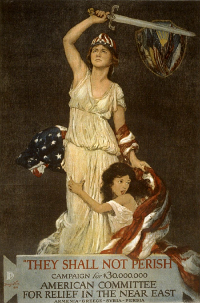
Young Turks overthrew the government of Sultan Hamid, bringing hope to Armenians living in the empire. However, during World War I and the Ottoman assault on Russia, the new government began to distrust the Armenians, because Armenian volunteers fought with the Russian army. Between 1915 and 1917, a large proportion of Armenians living in Anatolia perished in what is known as the Armenian Genocide. Armenians and Western historians regard this as state-sponsored mass killings, while Turkish authorities say the deaths were the result of a civil war coupled with disease and famine. Death toll estimates range from 650,000 to 1.5 million. These events are commemorated yearly on April 24, the Armenian Martyr Day.
The Russian army gained most of Ottoman Armenia during World War I, but lost in 1917 when the Bolshevik Revolution caused the army to withdraw. Eastern Armenia, Georgia, and Azerbaijan united in the Transcaucasian Democratic Federative Republic, until May 28, 1918, when that republic dissolved and eastern Armenia became independent as the Democratic Republic of Armenia, which lasted until December 4, 1920.
The Treaty of Sèvres, signed on August 10, 1920, promised to maintain the existence of the democratic republic and to attach the former territories of Ottoman Armenia to it. But the Turkish National Movement rejected the treaty, and Mustafa Kemal Atatürk used the treaty as the occasion to declare itself the rightful government of Turkey, replacing the monarchy based in Istanbul with a republic based in Ankara.
Soviet Armenia
A violent conflict, known as the Turkish-Armenian War, broke out in late 1920. The Treaty of Alexandropol, signed on December 2, forced Armenia to disarm, to cede more than 50 percent of its pre-war territory, and to give up territories granted by the Sèvres treaty. Meanwhile, the Soviet Eleventh Army had invaded Armenia at Karavansarai (present-day Ijevan) on November 29. By December 4, Soviet forces entered Yerevan, Bolshevist Russia annexed Armenia, and in 1922 was incorporated into the Soviet Union as part of the Transcaucasian SFSR along with Georgia and Azerbaijan. The 1921 Treaty of Kars, between Turkey and the Soviet Union, superseded the Treaty of Alexandropol. In it, Turkey allowed the Soviet Union to assume control over Ajara with the port city of Batumi in return for sovereignty over the cities of Kars, Ardahan, and Iğdır, all of which were part of Russian Armenia.
The TSFR existed from 1922 to 1936, when it was divided up into the Armenian SSR, Azerbaijan SSR, and the Georgian SSR. Soviet rule brought relative stability. Armenians received medicine, food, and other provisions from Moscow. The church struggled under Soviet rule. After the death of Vladimir Lenin, when Joseph Stalin took power, tens of thousands of Armenians were either executed or deported during Stalin's Great Purge.
Stalin died in 1953. Under Nikita Khruschev, life in Soviet Armenia improved. The church was revived when Catholicos Vazgen I assumed the duties of his office in 1955. In 1967, a memorial to the victims of the Armenian Genocide was built at the Tsitsernakaberd hill above the Hrazdan gorge in Yerevan after mass demonstrations took place the tragic event's 50th anniversary in 1965.
During Mikhail Gorbachev’s leadership in the 1980s, Armenians began to demand better environmental care for their country, opposing the pollution that Soviet-built factories brought. Tensions developed between the Armenian and Azerbaijani republics over the region of Nagorno-Karabakh. Armenia suffered the devastating 1988 Spitak earthquake. Gorbachev's inability to solve Armenia's problems (especially Karabakh) led many Armenians to become disillusioned, creating a hunger for independence.
Independence
In 1991, the Soviet Union broke apart and Armenia re-established its independence. The initial post-Soviet years were marred by the continued confrontation with Azerbaijan over Nagorno-Karabakh. A Russian-brokered cease-fire was put in place in 1994. Since then, Armenia and her neighbor have held peace talks, mediated by the Organization for Security and Co-operation in Europe. The status over Karabakh has yet to be determined and the economies of both countries have been hurt in the absence of a complete resolution.
Politics
As a former republic of the Soviet Union, Armenia is a unitary, multi-party, democratic nation-state. The politics of Armenia take place in a framework of a presidential representative democratic republic.
According to the Constitution of Armenia, the president, who is elected by popular vote for a five-year term, and is eligible for a second term, is the chief of state. The prime minister, who is appointed by the president and confirmed with the majority support of the National Assembly, is the head of government. The cabinet comprises a Council of Ministers appointed by the prime minister. The prime minister and Council of Ministers must resign if the National Assembly refuses to accept their program.
The unicameral parliament, called the Azgayin Zhoghov or National Assembly, comprises 131 members elected by popular vote to serve four-year terms. Ninety members are elected by party list, and 41 by direct vote. Universal suffrage begins above the age of 18.
Justice is administered by tribunal courts, review courts, and the Court of Appeal. There are military courts and a Constitutional Court comprising nine members, five appointed by the National Assembly and four by the president. The judiciary is nominally independent. The president is head of the Council of Justice and appoints its 14 members. In 1999, the Court of Appeal replaced the Supreme Court in criminal-military and civil-economic matters.
The Armenian government's stated aim is to build a Western-style parliamentary democracy. However, international observers have questioned the fairness of Armenia's parliamentary and presidential elections and constitutional referendum since 1995, citing polling deficiencies, lack of cooperation by the electoral commission, and poor maintenance of electoral lists and polling places.
The Armenian army, air force, air defense, and border guard comprise the four branches of the armed forces. The Armenian military was formed after the collapse of the Soviet Union in 1991 and with the establishment of the Ministry of Defense in 1992. The President of Armenia is Commander-in-Chief of the military. The Ministry of Defense is in charge of political leadership, while military command remains in the hands of the general staff, headed by the chief of staff.
Active forces number about 60,000 soldiers, with an additional reserve of 32,000, and a "reserve of the reserve" of 350,000 troops. Armenian guards are in charge of borders with Georgia and Azerbaijan, while Russian troops monitor its borders with Iran and Turkey. In the case of an eventual attack, Armenia is prepared to mobilize every able-bodied man between the age of 15 and 59, with military preparedness.
Armenia is divided into 10 regions known as marzes, with the city of Yerevan having special administrative status as the country's capital. The chief executive in each marze is the marzpet (marz governor), appointed by the government of Armenia. In Yerevan, the chief executive is the mayor, appointed by the president. The regions are: Aragatsotn, 1; Ararat, 2; Armavir, 3; Gegharkunik, 4; Kotayk, 5; Lori, 6; Shirak, 7; Syunik, 8; Tavush, 9; Vayots Dzor, 10; and Yerevan, 11.
Armenia is a member of the United Nations, the Council of Europe, Asian Development Bank, the Commonwealth of Independent States, the World Trade Organization and the Organization of the Black Sea Economic Cooperation. It is a Partnership for Peace (PfP) member of the North Atlantic Treaty Organization and in a military alliance of CSTO. It is also an observer member of the Eurasian Economic Community, La Francophonie, and the Non-Aligned Movement.
Economy
Before independence, Armenia's economy was largely industry-based – chemicals, electronics, machinery, processed food, synthetic rubber, and textiles – and highly dependent on outside resources. Agriculture contributed only 20 percent of net material product and 10 percent of employment before the break-up of the Soviet Union in 1991. The republic had developed a modern industrial sector, supplying machine tools, textiles, and other manufactured goods to sister republics in exchange for raw materials and energy.
Armenian mines produce copper, zinc, gold, and lead. The vast majority of energy is produced with fuel imported from Russia, including gas and nuclear fuel (for its one nuclear power plant); the main domestic energy source is hydroelectric. Small amounts of coal, gas, and petroleum have not yet been developed.
Like other newly-independent states of the former Soviet Union, Armenia's economy suffers from the legacy of a centrally planned economy and the breakdown of former Soviet trading patterns. Soviet investment in and support of Armenian industry has virtually disappeared, so that few major enterprises are still able to function.
The effects of the 1988 Spitak Earthquake, which killed more than 25,000 people and made 500,000 homeless, are still being felt. The conflict with Azerbaijan over Nagorno-Karabakh has not been resolved. The closure of Azerbaijani and Turkish borders has hindered the economy, because Armenia depends on outside supplies of energy and most raw materials. Land routes through Georgia and Iran are inadequate or unreliable.
Gross domestic product fell nearly 60 percent from 1989 until 1992–1993. The national currency, the dram, suffered hyperinflation for the first years after its introduction in 1993.
Nevertheless, the government was able to make wide-ranging economic reforms that paid off in dramatically lower inflation and steady growth. The 1994 cease-fire in the Nagorno-Karabakh conflict has helped the economy. Armenia has had strong economic growth since 1995, building on the turnaround that began the previous year, and inflation has been negligible for the past several years. New sectors, such as precious stone processing and jewelry making, information and communication technology, and even tourism are beginning to supplement more traditional sectors in the economy, such as agriculture.
Loans to Armenia, which since 1993 exceed $1.1-billion, are targeted at reducing the budget deficit, stabilizing the currency; developing private businesses; energy; the agriculture, food processing, transportation, and health and education sectors; and ongoing rehabilitation in the earthquake zone. One of the main sources of foreign direct investments remains the Armenian diaspora, which finances major parts of the reconstruction of infrastructure and other public projects.
A liberal foreign investment law was approved in June 1994, and a Law on Privatization was adopted in 1997, as well as a program on state property privatization. Unemployment remained at around 30 percent. In 2007 due to the influx of thousands of refugees from the Karabakh conflict.
According to the 2006 Transparency International Corruption Perceptions Index (CPI), Armenia ranked 93rd of 163 countries, a slight increase since it was first ranked in 2003, at 80th. In the 2007 Index of Economic Freedom, Armenia ranked 32nd, ahead of countries like Portugal and Italy.
Exports totaled $1.056-billion in 2006. Export commodities were diamonds, mineral products, foodstuffs, and energy. Export partners were Germany 15.6 percent, Netherlands 13.7 percent, Belgium 12.8 percent, Russia 12.2 percent, Israel 11.5 percent, the United States 11.2 percent, Georgia 4.8 percent, and others 18.2 percent.
Imports totaled $1.684-billion in 2006. Import commodities were natural gas, petroleum, tobacco products, foodstuffs, and diamonds. Import partners were Russia 13.5 percent, Belgium 8 percent, Germany 7.9 percent, Ukraine 7 percent, Turkmenistan 6.3 percent, U.S. 6.2 percent, Israel 5.8 percent, Iran 5 percent, Romania 4.2 percent, others 36.1 percent.
Per capita GDP was $4270 in 2005, or ranked 115 on a list of 181 countries.
Demographics
Armenia's nearly-homogeneous population is close to 3 million—the third most densely populated of the former Soviet republics. There has been increased emigration after the break-up of the USSR, and a moderate influx of Armenians returning.
Armenia has a relatively large diaspora – eight million by some estimates, greatly exceeding the 3.2 million population of Armenia itself. The largest diaspora communities are in Russia, France, Iran, the United States, Georgia, Syria, Lebanon, Argentina, and Ukraine. From 40,000 to 70,000 still live in Turkey mostly in and around Istanbul.
Western medicine is practiced, and under the Soviet system, health care was state-run and universal. A number of private clinics operate, some under the sponsorship of diaspora voluntary associations, such as the Armenian General Benevolent Union and the Armenian Relief Society. Life expectancy at birth for the total population in 2006 was 71.84 years, 68.25 years for males, 76.02 years for females.
Ethnicity
Ethnic Armenians make up the vast majority of the population, with a small number of Yazidis (Kurds). Other minorities include Russians,Assyrians, Ukrainians, Greeks, Poles, Caucasus Germans, Udis, and Tats. Most Azerbaijanis who lived in Armenia left the country for Azerbaijan at the beginning of the Nagorno-Karabakh conflict. During the same period, a large number of Armenians fled from Azerbaijan to Armenia.
Religion
Christianity is the predominant religion. The roots of the Armenian Apostolic Church go back to the first century. According to tradition, two of Jesus' 12 apostles—Thaddaeus and Bartholomew—who preached Christianity in Armenia between 40-60 C.E. started the Armenian Church. Because of these two founding apostles, the official name is the Armenian Apostolic Church. Armenia was the first nation to adopt Christianity as a state religion, in 301.
Over 93 percent of Armenian Christians belong to the Armenian Apostolic Church, a form of Oriental Orthodoxy, which is a very ritualistic, conservative church, roughly comparable to the Coptic and Syriac churches. Armenia also has a population of Catholics (both Roman and Mekhitarist - Armenian Uniate (180,000)), evangelical Protestants, and followers of the Armenian traditional religion.
The Yazidi Kurds, who live in the western part of the country, practice Yazidism. The Armenian Catholic Church is headquartered in Bzoummar, Lebanon. The non-Yazidi Kurds practice Sunni Islam.
The Jewish community in Armenia has diminished from 5000 to 750 persons since independence due to Armenia's economic difficulties, with most emigrants leaving for Israel. Two synagogues operate, one in the capital, Yerevan, and in the city of Sevan. Intermarriage with Christian Armenians is frequent.
Language
The Armenian language, an Indo-European language, is the official language. The Armenian language has been spoken since at least 800 B.C.E. The alphabet was written in 405 C.E. by the monk Mesrob Mashtots and comprises 38 letters. Western Armenian, based on a version of nineteenth century Armenian, is spoken in Istanbul and is used in the diaspora, and Eastern Armenian, based on the Armenian spoken in Yerevan, is used in the ex-Soviet countries and Iran. There is also "Grabar" Armenian, the original written language, which is still used in the liturgy of the church. When Armenia was under Russian and Soviet rule, Russian was the second official language. Ninety six percent of the population speak Armenian, while 75.8 percent additionally speaks Russian although English is becoming increasingly popular.
Men and women
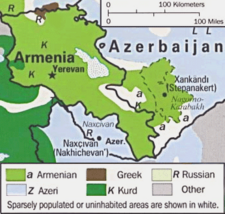
Women do the household chores, and the grandmother or mother-in-law is the household manager. Women and men both work outside the home, and have equal access to all jobs. Many women work, although more work in lower paid jobs. In 1991, during the first elections in the newly independent republic, women candidates won in nine constituencies out of 240. No parliamentary committees include female members.
Marriage and the family
Some marriages are arranged. The elaborate wedding process begins when the man and woman are "promised." The man's parents, grandparents, and often uncles and aunts, visit the woman's house seeking permission from the woman's father for the relationship to prosper. Once the father grants permission, the man gives the woman a "promise ring." To celebrate, the woman's family opens a bottle of Armenian cognac.
Most families have a substantial engagement party, organized and paid for by the girl's family. At the party, a priest prays for the soon-to-be husband and wife. They slide wedding bands on each other's right hands. The ring is moved to the left hand once a formal marriage ceremony is conducted by the Armenian church, usually one year later. The man and his family pay for the wedding, which is organized by the bride and groom to be.
Housing shortages in Soviet Armenia, meant the new couple resided with the groom's family, although the preference is that they form a new household. The most common domestic unit before and during Soviet rule consisted of a multi-generational family including paternal grandparents, their married offspring, and unmarried aunts and uncles. In 2007, the married couple and their children constituted the domestic unit. Armenians are known for having large and close family bonds. Regarding inheritance, men and women are treated equally.
Mothers are the main providers of infant care, and are responsible for child-rearing. Under Soviet rule, free day care was available, but many preferred to leave their infants with grandmothers. A Soviet pattern in which women were guaranteed employment after a long, paid maternity leave has continued. Children are the center of attention until puberty, when they are disciplined and are expected to take on responsibilities.
Education
Education, which is valued, is compulsory and free at primary and secondary level. Reflecting Soviet influence, the system places importance on science and technology, although by the mid-1990s more emphasis was placed on Armenian culture and history. In 2000, 155,423 pupils attended primary schools, and 389,131 pupils attended secondary schools, while 75,474 students were enrolled in higher education.
A private higher education system was introduced in 1992. By mid-1997, 75 of the 90 higher education institutions were private. The American University of Armenia has graduate programs in Business and Law, among others, and forms a new focal point for English-language intellectual life in the city.
Ninety percent of health-care students were women, and in arts and education women constitute 78 percent. Men accounted for 55.3 percent of economics courses, 59 percent of agriculture, and 40 percent for industry, transportation, and communications.
In 2001–2002 education spending amounted to 3.1 per cent of gross national product. The Armenian education system achieves a high literacy rate. In 2003, 98.6 percent of the entire population over the age of 15 could read and write.
Class
From the eleventh to fourteenth centuries, there were aristocratic noble houses with court responsibilities. Later, a middle class emerged. Most Armenians were peasants until the beginning of the twentieth century. The Soviet era brought a so-called classless society, although higher government positions brought political power and wealth. Since then a new elite has emerged, following the pattern under Soviet rule. Refugees form an underclass.
Culture
Armenian cuisine is closely related to eastern and Mediterranean cuisine. Staple foods are bread and salt. An Armenian saying of friendship is: "we have bread and salt among us." Dignitaries are welcomed with a presentation of bread and salt. The preparation of a large number of meat, fish and vegetable dishes in the Armenian kitchen requires stuffing, frothing and pureeing. Harissa a traditional meal, consists of wheat grain and lamb cooked over low heat. Meats and vegetables are barbecued. Breakfasts on non-working days are major get-togethers. Khash, cattle legs boiled in huge pots and served with spices and garlic, is consumed with Armenian brandy. Armenia is famous for its wine and brandy, which is renowned worldwide. The pomegranate is the national fruit.
Armenian hospitality is legendary and stems from ancient tradition. Social gatherings center on sumptuous presentations of course after course of elaborately prepared and well-seasoned food. Hosts will replenish a guest's plate or glass. After several replenishments, it is acceptable to refuse politely or just leave a little uneaten food. Cognac, vodka, and red wine is served during meals and gatherings. It is rare to enter an Armenian household and not be offered coffee, pastry, food, or water.
Architecture
Armenia’s long history as a crossroads of the ancient world has resulted in a landscape with innumerable fascinating archaeological sites. Medieval, Iron Age, Bronze Age and even Stone Age sites are all within a few hours drive of the city.
Contemporary Armenian architecture has followed a tradition of simplicity, reliance on local materials, and use of volcanic tufa for facings. During the Soviet era, prefabricated panels were used in apartment buildings, many of which collapsed during the 1988 earthquake.
Art
The National Art Gallery in Yerevan has more than 16,000 works that date back to the Middle Ages, illustrating Armenia's rich tales, as well as paintings by many European masters. The Modern Art Museum, the Children’s Picture Gallery, and the Martiros Saryan Museum are only a few of the other noteworthy collections of fine art on display in Yerevan.
Dance
In Armenia there are rock paintings of scenes of country dancing from the fifth to the third millennia B.C.E. In the fifth century Moses of Khorene had heard of how the old descendants of Aram (Armenians) recorded traditions in the ballads for the lyre and their songs and dances. Traditional dancing is popular among expatriate Armenians, and has been `exported' to folk dance groups all over the world.
Cinema
Soviet Armenia (1924) was the first Armenian documentary film. Namus was the first Armenian silent black-and-white film (1926, directed by Amo Bek-Nazaryan and based on a play of Alexander Shirvanzade describing the ill fate of two lovers, who were engaged by their families to each other since childhood, but because of violations of namus (a tradition of honor), the girl was married by her father to another.
Lacemaking
Like Lacis, or Filet lace, Armenian needlelace seems to be a descendant of netmaking. Where lacis adds decorative stitches to a net ground, Armenian needlelace involves making the net itself decorative. There is some archaeological evidence suggesting the use of lace in prehistoric Armenia and the prevalence of pre-Christian symbolism in traditional designs would certainly suggest a pre-Christian root for this art form. Unlike Europe, where lace was the preserve of the nobility, Armenian lace decorated everything from traditional headscarves to lingerie. Thus lacemaking was part of many women's lives.
Literature
The Armenians once had a temple literature of their own, which was destroyed in the fourth and fifth centuries by the Christian clergy, so thoroughly that barely 20 lines of it survive in the history of Moses of Khorene. Literature began in Armenia around 400 C.E. Most literary arts were created by Moses of Khorene, in the fifth century. Stories and myths changed as they were passed on through generations. During the nineteenth century, writer Mikael Nalbandian worked to create a new Armenian literary identity. Nalbandian's poem "Song of the Italian Girl" may have been the inspiration for the Armenian national anthem, Mer Hayrenik. Notable writers during the nineteenth and twentieth centuries include Siamanto, Hagop Baronian, Vahan Tekeyan, Levon Shant, Krikor Zohrab, Rupen Zartarian, Avetis Aharonian, Garegin Njdeh, Atrpet, Gostan Zarian and Nigol Aghpalian.
Music
The world-class Armenian Philharmonic Orchestra performs at the beautifully refurbished Yerevan Opera House, where one can attend a full season of opera. There are several highly regarded chamber ensembles, including the National Chamber Orchestra of Armenia and the Serenade Orchestra. Classical music can be heard at the Yerevan Komitas State Conservatory and the Chamber Orchestra Hall. Jazz is popular, especially in the summer when live performances are a regular occurrence at one of the city’s many outdoor cafés and parks. Members of the nu-metal band called "System of a Down" are all of Armenian descent, although only bassist Shavo Odadjian is from the country.
Sports
Armenian princes and nobles contested the ancient Olympics. In the twenty first century, many types of sports are played in Armenia, including football (soccer), chess, boxing, basketball, hockey and volleyball. Armenia's mountainous terrain gives the opportunity for skiing and climbing. Water sports can be practiced on Lake Sevan. Competitively, Armenia has been successful in weightlifting and wrestling. Armenia belongs to the Union of European Football (soccer) Associations and International Ice Hockey Federation. It hosts the Pan-Armenian games.
Notes
- ↑ The Constitution of the Republic of Armenia. Retrieved July 2, 2018.
- ↑ 2.0 2.1 2.2 CIA, Armenia The World Factbook.
- ↑ 3.0 3.1 3.2 3.3 International Monetary Fund, Report for Selected Countries and Subjects World Economic Outlook Database, April 2018. Retrieved July 2, 2018.
References
ISBN links support NWE through referral fees
- Agatʻangeghos, and Robert W. Thomson. History of the Armenians. Albany, NY: State University of New York Press, 1976. ISBN 0873953231
- Bauer-Manndorff, Elisabeth, and Jacob Schmidheiny. Armenia, past and present. Lucerne: Reich Verlag, 1981.
- Cox, Caroline, John Eibner, and Elena Bonnėr. Ethnic cleansing in progress: war in Nagorno Karabakh. Zürich: Institute for Religious Minorities in the Islamic World, 1993. ISBN 3952034525
- Bournoutian, George A. A concise history of the Armenian people: (from ancient times to the present). Costa Mesa, CA: Mazda Publishers, 2003. ISBN 1568591411
- Lang, David Marshall. Armenia, cradle of civilization. London: Allen & Unwin, 1978. ISBN 0049560085
- Movsisyan, A. E. The sacred highlands: Armenia in the spiritual geography of the ancient Near East. Yerevan: Yerevan University Publishers, 2004. ISBN 5808405866
- Russell, James R. Zoroastrianism in Armenia. Boston, MA: Harvard University Press, 1987. ISBN 978-0674968509
- Russell, James R. Armenia and Iran: iii. Armenian religion Encyclopedia Iranica. Retrieved July 2, 2018.
- Thierry, Jean Michel, Patrick Donabédian, and Nicole Thierry. Armenian art. New York: H. N. Abrams in association with Prelacy of the Armenian Apostolic Church of America-Catholicosate of Cilicia, 1989. ISBN 0810906252
- Utudjian, Edouard. Armenian architecture, 4th to 17th century. Paris: Editions A. Morancé, 1968. OCLC 464421
- Walker, Christopher J. Armenia, the survival of a nation. New York, NY: St. Martin's Press, 1980. OCLC 6280619
External links
All links retrieved November 6, 2021.
- National Statistical Service of Armenia National Statistical Service.
- Constitutional Court of Armenia Constitutional Court of Armenia.
- Armeniapedia.org - Armenian wiki Armeniapedia (primarily English).
- Armenia CIA World Factbook.
- Armenia Countries and Their Cultures.
Credits
New World Encyclopedia writers and editors rewrote and completed the Wikipedia article in accordance with New World Encyclopedia standards. This article abides by terms of the Creative Commons CC-by-sa 3.0 License (CC-by-sa), which may be used and disseminated with proper attribution. Credit is due under the terms of this license that can reference both the New World Encyclopedia contributors and the selfless volunteer contributors of the Wikimedia Foundation. To cite this article click here for a list of acceptable citing formats.The history of earlier contributions by wikipedians is accessible to researchers here:
- Armenia history
- History_of_Armenia history
- Geography_of_Armenia history
- Politics_of_Armenia history
- Economy_of_Armenia history
- Demographics_of_Armenia history
- Culture_of_Armenia history
- Sport_in_Armenia history
- Armenian_cuisine history
- Music_of_Armenia history
- Armenian_architecture history
- Armenian_literature history
The history of this article since it was imported to New World Encyclopedia:
Note: Some restrictions may apply to use of individual images which are separately licensed.
↧ Download as ZWI file | Last modified: 02/03/2023 22:38:56 | 47 views
☰ Source: https://www.newworldencyclopedia.org/entry/Armenia | License: CC BY-SA 3.0
 ZWI signed:
ZWI signed:

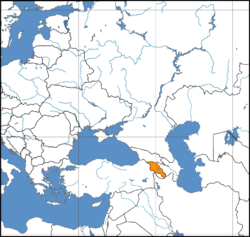
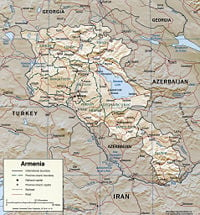
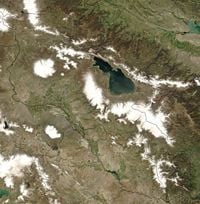
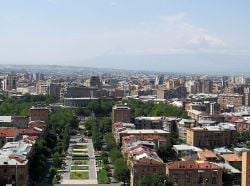
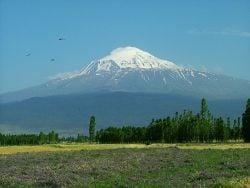
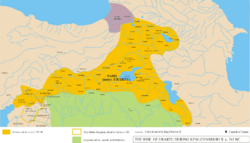
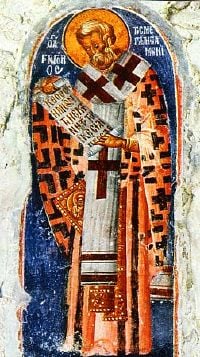
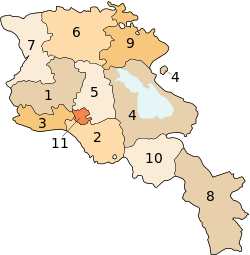
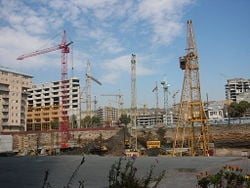

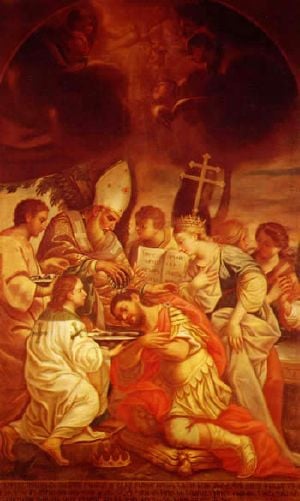
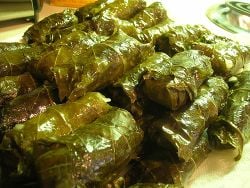
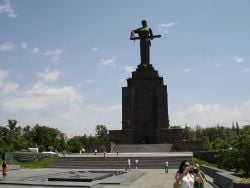

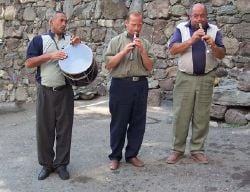
 KSF
KSF